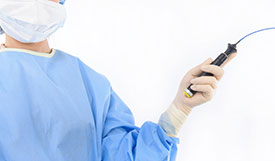Office of Research & Development |
 |
March 18, 2019

Cardiac ablation involves threading a long, flexible tube through a vein or artery all the way to the heart. (Photo: ©iStock/NunoMonteiro)
VA research with dog models in the 1990s and 2000s was crucial in the development of cardiac ablation as a way to treat cardiac arrhythmia. Cardiac arrhythmia is a heart condition in which the heart beats too fast, too slow, or irregularly. Untreated arrhythmias may have serious consequences, such as heart attack and stroke.
Cardiac ablation involves threading a long, flexible tube through a vein or artery all the way to the heart. Energy, in the form of heat (radiofrequency ablation, similar to microwave heat) or extreme cold (cryoablation), is used to scar or destroy abnormal heart tissue, which cures the arrhythmia. The VA research contributed to the evolution of the instruments used and the optimization of the intensity and duration of the ablation energy applied. This has become a routine procedure for the clinical treatment of cardiac arrhythmias.
Principal investigator: Warren M. Jackman, M.D.; Oklahoma City VA Health Care System
Selected publications:
Radiofrequency catheter ablation with the split-tip electrode in the temperature-controlled mode. Antz M, Otomo K, Nakagawa H, Yamanashi WS, Jackman WM, Kuck KH. Pacing Clin Electrophysiol. 2001 Dec;24(12):1765-73.
Minimally invasive pulmonary vein isolation and partial autonomic denervation for surgical treatment of atrial fibrillation. J Interv Car Electrophysiol. 2007 Dec;20(3):89-93.
Catheter ablation in patients with cardiac arrhythmias. DiMarco JP, Prystowsky EN, Ellenbogen KA, Horowitz LN, Naccarelli GV, Jackman WM, Laks MM. Circulation. 1992 Jan;85(1):390.